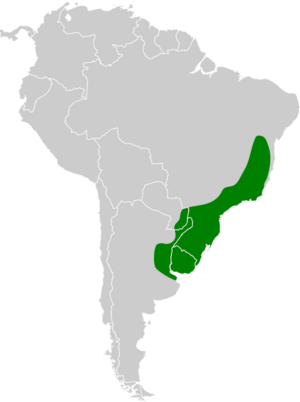Spix's spinetail facts for kids
Quick facts for kids Spix's spinetail |
|
|---|---|
 |
|
| Conservation status | |
| Scientific classification | |
| Genus: |
Synallaxis
|
| Species: |
spixi
|
 |
|
The Spix's spinetail (Synallaxis spixi) is a small bird. It used to be called the chicli spinetail. This bird is part of the ovenbird family, which is known for building unique nests.
You can find Spix's spinetails in several South American countries. These include Argentina, Brazil, Paraguay, and Uruguay.
Contents
About the Spix's Spinetail Bird
The Spix's spinetail is a unique bird species. It is the only member of its specific group, meaning it doesn't have any subspecies.
Another bird, the cinereous-breasted spinetail, was once thought to be a type of Spix's spinetail. However, scientists now know they are separate but closely related species.
The name "Spix's spinetail" honors a German scientist named Johann Baptist von Spix. The old name "chicli spinetail" was supposed to sound like the bird's call. But it actually doesn't sound like it at all! It's believed that name might have originally been for a different bird.
What Does a Spix's Spinetail Look Like?
Spix's spinetails are about 16 to 17 centimeters (6 to 7 inches) long. They weigh around 12 to 15 grams (0.4 to 0.5 ounces). Both male and female birds look the same.
Adult birds have a light gray stripe above their eyes. Their face is mostly grayish-brown. The top of their head is reddish-brown. Their back, rump, and upper tail feathers are dark brown.
Their wings have reddish-brown and dark brown feathers. Their tail is dark brown and gets narrower towards the end. The middle tail feathers have pointy tips.
The throat of the Spix's spinetail is grayish-white. The lower throat feathers have black centers with gray edges. Their chest is brownish-gray, and their belly is a lighter brownish-gray. Their sides and under-tail feathers are browner.
Their eyes can be reddish-brown or light orange. Their upper beak is black, and their lower beak is gray. Their legs and feet are gray to greenish-gray.
Young Spix's spinetails have a grayish-brown head. Their underside is a yellowish-brown color. Their throat patch is not as clear as in adult birds.
Where Spix's Spinetails Live and Their Habitat
Spix's spinetails live in southeastern Brazil, eastern Paraguay, and almost all of Uruguay. They also live in Argentina, reaching as far south as Buenos Aires Province.
These birds live in many different places within the Atlantic Forest region. They usually stay low in thick bushes and plants. You can find them in fields, pastures, and forests along rivers. They also live in rocky grasslands, coastal areas, savannas, and areas where new plants are growing after old ones were cleared.
They can live from sea level up to about 2,200 meters (7,200 feet) high. In Brazil, they are found up to 2,050 meters (6,700 feet) high.
Spix's Spinetail Behavior
Spix's spinetails stay in the same area all year round. They do not migrate.
What Spix's Spinetails Eat
We don't know all the details about what Spix's spinetails eat. However, we do know they eat insects. They usually search for food in pairs. They often look for food in the lower parts of bushes or sometimes on the ground. They typically stay within 5 meters (16 feet) of the ground while feeding.
Reproduction and Life Cycle
The breeding season for Spix's spinetails is not fully known. But it includes the months from November to February.
Their nest is shaped like a long dome. It's made of spiny sticks and has a long tube-like entrance on the side. They build these nests in shrubs or bushes, usually up to about 2 meters (6.5 feet) above the ground.
The inside of the nest is lined with soft materials. These can include moss, animal hair, and small leaves. They almost always add shed skins from snakes and lizards to the nest.
Scientists have found nests with two to five eggs. We don't know how long the eggs take to hatch. We also don't know how long it takes for the young birds to leave the nest. Details about how the parents care for their young are also not known.
How Spix's Spinetails Communicate (Vocalization)
The song of the Spix's spinetail has been described in a few ways. One description is a "five syllable phrase" with a "bubbling quality." It sounds like "sweet! bee bee bee bee . . . . . .sweet! bee bee bee bee . . . ." Another way to describe it is a repeated "wee'tiddledidee....wee'tiddledidee." They also make a "4- or 5-noted 'wuh-wididit' " sound.
Spix's Spinetail Conservation Status
The IUCN (International Union for Conservation of Nature) has evaluated the Spix's spinetail. They have listed it as a species of "Least Concern." This means it is not currently at risk of disappearing.
The bird lives in a large area. Its total population size is not known, but it is believed to be growing. There are no immediate threats that scientists have found. It is considered to be a fairly common to very common bird.
Spix's spinetails live in dense, bushy areas where new plants are growing. This bird might even benefit from some deforestation. This is true as long as there are still dense, low woody plants left for them to live in.


